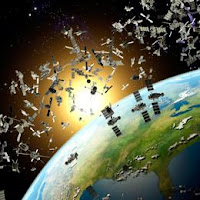The Kessler Syndrome, proposed in 1978 by a former scientist from NASA, Donald J. Kessler, is a scenario[1] in which the density of objects in Low Earth Orbit (LEO) is high enough that a single collision between two objects could cause a cascade – each collision generating space debris which increases the likelihood of further collisions. Which means that there’s nowadays so much junk in space that one collision could result in a multitude of others. That in turn could lead to debris being knocked off course and that could be directed to earth.
Every satellite, space probe, and manned mission has the potential to create or become space debris. As the number of satellites in orbit around the earth grows and old satellites become obsolete, the risk of a cascading Kessler syndrome becomes ever greater[2].
The Kessler Syndrome is therefore not a syndrome in the medical sense of the word, but it could certainly generate quite a few headaches. And deaths.
[1] Kessler et al: Collision frequency of artificial satellites: The creation of a debris belt in Journal of Geophysical Research - 1978
[2] Liang et al: On the Increased Risk of Kessler Syndrome by Anti-Satellite Tests in Journal of the Astronautical Science. See here.

Geen opmerkingen:
Een reactie posten